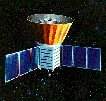
COBE
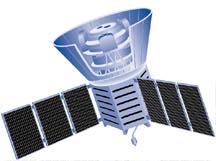 COsmic
Background
Explorer
COsmic
Background
Explorer
NASA's COBE (Cosmic Bakground Explorer) satellite was developed to measure
the diffuxe infrared and cosmic microwave background radiation from the
early Universe to the limits set by our astrophysical environment.
COBE was launched on November 18, 1989 and carried three instruments:
DIRBE (the Diffuse InfraRed Experiment) to search for and measure
the cosmic infrared background radiation,
DMR (Differential Microwave Radiometers) to map the cosmic microwave
background radiation precisely, and
FIRAS (Far-InfaRed Absolute Spectrophotometer) to compare the
spectrum of the cosmic microwave background radiation with that from
a precise blackbody.
Data from the full four years of COBE observations continue to be analyzed.
Student and post doctoral opportunities exist.
A large number of
people
were involved at various stages in the COBE project.
DIRBE has mapped the absolute sky brightness in 10 wavelength bands
ranging from 1.25 microns to 240 microns. These data contain the signal
from the cosmic infrared background and the foreground emissions from
extragalactic sources, our Galaxy, and dust and other sources in our solar
system. Work is in progress on separating and modeling the varios components.
Significantly improved limits on the cosmic infrared background exist
and future progress is possible and likely.
A significant amount of work involves study of the astrophysics of the
interesting foreground sources. There is a very rich data base on the infrared emission from the Galaxy and the interplanetary dust.
Galactic plane emission: bands 1-5
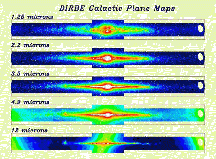
Galactic plane emission: bands 6-10
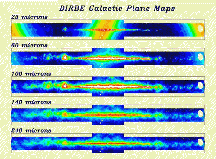
The COBE DMR ( Smoot et al. 1992 )
has found anisotropies in the cosmic microwave background on all scales
from the nominal beam size of 7-degrees up to the full sky at a typical
level of one part in 100,000 to a few parts per million. These anisotropies
are interpreted as imprints of the seeds that eventually grew under the
influence of gravity to galaxies, clusters of galaxies, and clusters of
clusters of galaxies. They also indicate that we should eventually expect
to find even larger scale structures. They also give us a clue
to how the Universe originated - i.e. how space and time and all the
other contents of the Universe came into being.
Two of the four years of the COBE DMR data have been released.
Data processing of all four years are in progress and the
full four year data were released in January 1996.
The DMR team
had a large number of memembers over the years
in addition to those from the COBE science working group that participated.
 DMR Schematic
DMR Schematic
 CMB Fluctuations (2 years of data)
CMB Fluctuations (2 years of data)
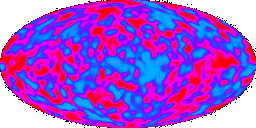 CMB Fluctuations (galaxy removed)
CMB Fluctuations (galaxy removed)
DMR Four Year DMR images of the
Cosmic Microwave Background Fluctuations.
FIRAS has shown that the cosmic microwave background spectrum matches
that of a blackbody of temperature 2.726K with a precision of 0.03%
of the peak intensity over a wavelength range 0.1 to 5 mm.
Longer wavelength measurements, though not nearly as precise,
conducted by Smoot's group at LBL and collaborators and by other groups,
show that the CMB spectrum is well-described by a single temperature blackbody.
See figure [attach Intensity and Temperature plots] of spectrum measurements.
These measurements limit possible alternative models to the Big Bang
extremely strongly and limit potential energy releases in the early
Universe, typically to less than 0.1% to 0.01%.
Extensive information about the COBE mission, including much information
about the three experiments on board, is available by clicking on
more COBE information
or through the NASA's NSSDC & Goddard Space Flight Center maintained
COBE Home Page.
More photographs
related to and of COBE.
NASA was responsibile for the development of the COBE satellite and
mission operations. Scientific Guidance was provided by the COBE
Science Working Group.
Return to the Smoot Group
page for a complete description of Dr. Smoot's group's research activities.
Revised 9 February 1997; smoot@cosmos.lbl.gov

 COsmic
Background
Explorer
COsmic
Background
Explorer

 COsmic
Background
Explorer
COsmic
Background
Explorer


 CMB Fluctuations (2 years of data)
CMB Fluctuations (2 years of data)
 CMB Fluctuations (galaxy removed)
CMB Fluctuations (galaxy removed)